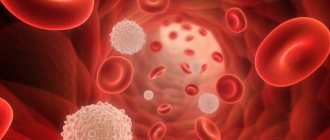Chronic lymphocytic leukemia is a malignant lymphoproliferative disease in which the tumor cells are pathological B lymphocytes that can accumulate in the bone marrow, peripheral blood and lymph nodes. Normally, B lymphocytes during their life transform into an immunoglobulin-secreting cell, which provides acquired immunity. Tumor B-lymphocytes are deprived of this function, and, thus, the patient’s immunity suffers and the risk of infectious diseases increases. In addition, as the disease progresses, the production of red blood cells, neutrophils and platelets is impaired, and autoimmune processes may develop. Finally, chronic lymphocytic leukemia can transform into B-cell prolymphocytic leukemia, into well-differentiated non-Hodgkin lymphoma, in particular into diffuse large B-cell lymphoma.
- Reasons for the development of lymphocytic leukemia
- Symptoms
- Diagnosis of chronic lymphocytic leukemia
- Stages of the disease
- Treatment
- Evaluation of treatment effectiveness
- Forecast
Reasons for the development of lymphocytic leukemia
Chronic leukemia is the most common type of leukemia, accounting for up to 30% of the total incidence structure. The incidence rate is 4 cases per 100 thousand population; in persons over 80 years of age, the frequency is more than 30 cases per 100 thousand population.
Risk factors for the development of chronic lymphocytic leukemia are:
- Elderly age. Up to 70% of all identified cases occur in people over 60 years of age,
- Male gender. Men get sick twice as often as women,
- Exposure to ionizing radiation,
- Contact with benzene and gasoline.
Symptoms
Chronic lymphocytic leukemia is characterized by a long asymptomatic course; The main reason for visiting a doctor is changes in a general blood test taken as part of a preventive examination or for another disease. The patient may not present active complaints at the time of the initial examination, but often even in this situation an enlargement of the lymph nodes and a change in their consistency to a doughy consistency are already detected. The lymph nodes themselves are not compacted and remain mobile relative to the surrounding tissues. In case of infection, the lymph nodes become significantly enlarged; As chronic lymphocytic leukemia progresses, lymph nodes—primarily those of the abdominal cavity—are capable of forming conglomerates.
The first complaints that arise are usually not specific: increased fatigue, weakness, severe sweating. As the disease progresses, autoimmune manifestations may occur, firstly very hemolytic anemia (in 10-25% of cases) and thrombocytopenia (in 2-3% of cases). Hemolytic anemia develops due to the destruction of red blood cells by the body itself; Most often, like chronic lymphocytic leukemia itself, it develops gradually, but it can also manifest as an acute crisis - with an increase in temperature, the appearance of jaundice, and darkening of the urine. Thrombocytopenia can be a much more dangerous condition due to the development of bleeding, including life-threatening bleeding (for example, cerebral hemorrhage).
In addition, since B lymphocytes belong to the cells that provide immunity, the addition of infectious complications, including opportunistic ones, that is, caused by microorganisms that are constantly present in the human body and do not manifest themselves with an adequate immune response, is typical. Most often, opportunistic infections affect the lungs.
Symptoms of CLL
Initially, the disease is asymptomatic, there are no clear complaints, but frequent respiratory infections, sweating, and weakness are noted. There may be some enlargement of the lymph nodes. In other words, nothing specific. At this stage, chronic leukemia is discovered accidentally when the patient undergoes a general blood test for routine examination or when diagnosing another disease. With a benign course, this condition can last for years, but then progression inevitably occurs and the advanced stage of the process begins.
At an advanced stage of the disease, patients present the following complaints:
- General weakness.
- Decreased performance.
- Night sweats.
- Sudden weight loss for no particular reason.
- Increased temperature without signs of infection.
- Lymphadenopathy.
The advanced stage is replaced by the terminal stage. Here, exhaustion, severe intoxication, severe generalized infections, disruption of the functioning of internal organs (renal failure, cardiomyopathies, etc.) are already observed. When the brain is infiltrated by tumor cells, consciousness is impaired, even to the point of coma.
Diagnosis of chronic lymphocytic leukemia
The diagnosis of chronic lymphocytic leukemia can be suspected when assessing the results of a routine clinical blood test - an increase in the absolute number of lymphocytes and leukocytes attracts attention. The main diagnostic criterion is the absolute number of lymphocytes, exceeding 5 × 10 9 \l and progressively increasing as lymphocytic leukemia develops, reaching numbers of 100-500 × 10 9 \ l. It is important to pay attention not only to the absolute number - if at the beginning of the disease lymphocytes make up up to 60-70% of the total number of leukocytes, then with its further development they can make up 95-99%. Other blood parameters, such as hemoglobin and platelets, may be normal, but as the disease progresses, they may decrease. The absolute criterion for establishing a diagnosis of chronic lymphocytic leukemia is the detection of more than 5000 clonal B lymphocytes in 1 μl of peripheral blood.
A biochemical blood test may reveal a decrease in total protein and the amount of immunoglobulins, but this is typical for later stages of the disease. A mandatory step in the diagnostic search is a bone marrow biopsy. Histological examination of the obtained punctate in the early stages of the disease, as well as in a general blood test, reveals a small content of lymphocytes (40–50%), but with high leukocytosis, lymphocytes can make up 95–98% of the bone marrow elements.
Since changes in the bone marrow are nonspecific, the final diagnosis of chronic lymphocytic leukemia is established on the basis of immunohistochemical studies. The characteristic immunophenotype of chronic lymphocytic leukemia includes the expression of antigens CD19, CD5, CD20, CD23; there is also weak expression on the cell surface of immunoglobulins IgM (often simultaneously with IgD) and antigens CD20 and CD22. The main cytogenetic marker that directly influences the choice of therapy is the 17p deletion. It is advisable to perform an analysis aimed at identifying this deletion before starting treatment, since its identification leads to a change in patient management tactics. In addition to a bone marrow biopsy, in the case of significant enlargement of individual lymph nodes, puncture of them is indicated in order to exclude lymphoma.
Instrumental diagnostic methods include chest x-ray and ultrasound of the most commonly affected groups of lymph nodes and abdominal organs - primarily the liver and spleen, since these organs are most often affected by chronic lymphocytic leukemia.
Stages of the disease
Currently, staging is carried out according to the classification proposed by Binet:
- A - hemoglobin content more than 100 g\l, platelets - more than 100 × 10 9\l, less than three lymphatic areas are affected (these include: cervical lymph nodes, axillary lymph nodes, inguinal lymph nodes, liver, spleen),
- B - hemoglobin content more than 100 g\l, platelets - more than 100 × 10 9\l, more than three lymphatic areas are affected,
- C - hemoglobin content less than 100 g\ or platelets - less than 100 × 10 9\l.
In addition to the Binet classification, the Rai classification is used, mainly used in the USA. According to it, there are four stages of the disease:
- 0 - clinical manifestations include only an increase in lymphocytes of more than 15 × 10 9 in the peripheral blood and more than 40% in the bone marrow,
- I - the number of lymphocytes is increased, enlarged lymph nodes are diagnosed,
- II - the number of lymphocytes is increased, an enlargement of the liver and/or spleen is diagnosed, regardless of the enlargement of the lymph nodes,
- III - there is an increase in the number of lymphocytes and a decrease in hemoglobin level of less than 110 g/l, regardless of the enlargement of the spleen, liver and lymph nodes,
- IV - there is an increase in the number of lymphocytes and a decrease in the number of platelets less than 100 × 10 9, regardless of the level of hemoglobin, enlargement of organs and lymph nodes.
Stage 0 is characterized by a favorable prognosis, stage I and II - intermediate, stage III and IV - unfavorable.
Treatment
Currently, chronic lymphocytic leukemia is highly treatable thanks to a wide range of chemotherapy drugs. It is important to note that current guidelines do not recommend starting aggressive treatment immediately after diagnosis - in cases where clinical manifestations are minimal, active follow-up is possible until indications for specific treatment arise, which include:
- The emergence or increase of intoxication, which is manifested by a loss of body weight by more than 10% over six months, a deterioration in general condition; the appearance of fever, low-grade fever, night sweats.
- Increasing symptoms of anemia and/or thrombocytopenia;
- Autoimmune anemia and/or thrombocytopenia - if the condition is not corrected with prednisone;
- Significant size of the spleen - the lower edge is at a distance of >6 cm or more below the costal arch;
- The size of the affected lymph nodes is more than 10 cm or its progressive increase;
- Increase in the number of lymphocytes by more than 50% in 2 months, or doubled in 6 months.
The main treatment method for chronic lymphocytic leukemia at the moment is chemotherapy. One of the first chemotherapeutic agents that showed its effectiveness in the treatment of chronic lymphocytic leukemia, chlorambucil, is still used today, albeit to a limited extent. Over time, cyclophosphamide has been used instead of chlorambucil, in combination with other drugs, and appropriate regimens (eg, CHOP, COP, CAP) are currently used in young patients with good physical status.
First introduced into clinical practice in the 80s of the last century, fludarabine showed effectiveness in achieving stable remission, exceeding the effectiveness of chlorambucil, especially in combination with cyclophosphamide. It is important to note that this regimen is effective even in the event of a relapse of the disease. The last word in the treatment of chronic leukemia is currently the use of immunotherapeutic agents - drugs from the group of monoclonal bodies. Rituximab has become firmly established in routine clinical practice. This drug interacts with the CD20 antigen, which is limitedly expressed in chronic lymphocytic leukemia, so effective treatment requires a combination of rituximab with one of the accepted chemotherapy regimens, most often with fludarabine or COP. Rituximab alone can be used as maintenance therapy in case of partial response to treatment.
The use of the drug alemtuzumab, which interacts with the CD52 antigen, looks promising. It is also used both alone and in combination with fludarabine.
Separately, I would like to mention chronic lymphocytic leukemia with 17p deletion. This subtype of lymphocytic leukemia is often resistant to standard chemotherapy regimens.
Some success in the treatment of this subtype of lymphocytic leukemia has been achieved through the use of the above-mentioned alemtuzumab. In addition, ibrutinib is a promising drug in this situation. Currently, this drug is used in monotherapy; its combination with various chemotherapy regimens is being studied; A regimen including ibrutinib, another monoclonal body, rituximab, and bendamustine, showed a certain advantage.
Radiation therapy, which a century ago was practically the only treatment option for such patients, has not lost its relevance to this day: it is recommended that it be carried out as part of an integrated approach to the area of the affected lymph nodes if their continued growth is observed against the background of stabilization of other manifestations of the disease. In this case, the required total dose is 20-30 Gy. Also, the radiation method can be used for relapses of the disease.
In the treatment of chronic lymphocytic leukemia, a surgical method has also found its place, which consists in removing the affected spleen. Indications for this intervention are:
- Enlarged spleen in combination with severe anemia and/or thrombocytopenia, especially if chemoresistance is observed,
- Massive enlargement of the spleen in the absence of response to chemotherapy,
- Severe autoimmune anemia and/or thrombocytopenia with resistance to drug treatment.
If resistance to previously used chemotherapy agents develops or if there is rapid progression after treatment, bone marrow transplantation may be performed. Bone marrow transplantation is indicated in first remission for high-risk patients, young patients in the absence of treatment effect, and patients with 17p deletion/TP53 mutation in the presence of disease progression. It is important to note that after transplantation, the use of rituximab and lenalidomide as maintenance therapy is recommended to prevent relapse.
Finally, patients require maintenance therapy, which includes:
- Transfusion of red blood cells for anemia;
- Platelet transfusion for bleeding caused by thrombocytopenia;
- Antimicrobial agents in case of bacterial, fungal or viral infection, as well as for its prevention;
- Use of prednisolone at a dose of 1-2 mg/kg in the development of autoimmune processes.
In the event of a relapse of the disease, treatment tactics depend on a number of factors, such as: previously administered therapy, the timing of the relapse, and the clinical picture. In case of early (that is, occurring within 24 months or earlier) relapse, the main drug is ibrutinib. It is used both independently and as part of the above-mentioned treatment regimen (ibrutinib + rituximab + bendamustine).
Alemtuzumab may be an alternative drug of choice. While demonstrating comparable efficacy to ibrutinib, it, however, exhibits significantly greater toxicity.
Finally, in some patients, bone marrow transplantation can be performed for early relapse of chronic lymphocytic leukemia.
In case of late relapse (occurring more than 24 months after completion of treatment), the main selection criterion is the early therapy performed.
- If previous fludarabine-based therapy was not accompanied by significant toxicity, then you can return to this regimen and also supplement it with rituximab.
- If cytopenia is detected, it is possible to use rituximab in combination with high doses of glucocorticosteroids.
- In case of previous treatment with chlorambucil, the use of regimens with fludarabine or a combination of bendamustine and rituximab is indicated.
- Monotherapy with ibrutinib or its combination with one of the polychemotherapy regimens can also be effective in relapsed chronic lymphocytic leukemia.
What is CLL and how is it treated?
Oncohematologist Elena Stadnik about chronic lymphoblastic leukemia
Oddly enough, cancer can be chronic. Sometimes they do not even require treatment (but only observation). In other cases, treatment can last a lifetime...
Who makes the diagnosis?
CLL, or chronic lymphocytic leukemia, is characterized by the progressive accumulation of phenotypically mature malignant B lymphocytes. This is a very insidious malignant blood disease. The fact is that it can “lurk” in the body for many years without making itself felt. As a rule, they find it by accident. Maybe an attentive therapist will notice a high level of white blood cells and refer you to a hematologist, or maybe someone will pay attention to enlarged lymph nodes, fatigue, night sweats and temperature.
In order to confirm the diagnosis, you need to do a test. This is a blood test called immunophenotyping. This method allows you to identify and count groups of leukocytes using monoclonal antibodies that are formed against cell surface antigens. Immunophenotyping makes it possible to determine their type and functional state by the presence of a particular set of cellular markers. Simply put, disease cells are found as if according to their passport data. To make a diagnosis of CLL, you don’t need to do scary tests like a bone marrow biopsy: the disease cells in the bone marrow are the same as those in the peripheral blood. In large cities, the result of such a test can be obtained in two hours.
Who is sick?
It used to be that CLL was a disease of grandparents. Young patients, although rare, were encountered. However, no one diagnosed them with CLL. Typically, their condition was diagnosed as non-Hodgkin's lymphoma and, as a result, was treated incorrectly. Now, thanks to high-quality diagnostics, the diagnosis has become younger. There are also patients under 30, but this is still rare.
Indications for treatment?
For many, CLL sounds like an immediate death sentence. However, this diagnosis is not at all a signal to action. Patients with dormant leukemia are not treated. They are being watched. When CLL patients learn of their diagnosis, they find it difficult to believe that the disease will not need to be treated for a while. They rush to turn to foreign doctors for help, wasting time, money and effort, but the answer they receive is the same: wait. Of course, it is unbearably difficult to wait and think every day whether something terrible will happen. But CLL is not the sword of Damocles. Don't think that trouble will come tomorrow. They live with the disease, they treat it...
Here are the indications for starting treatment:
- Anemia, decreased platelet count.
- Bleeding, infections.
- Enlarged lymph nodes.
— The doubling time of leukocytes is less than two months.
- Complications, especially autoimmune ones.
- Special symptoms: fever, weakness, night sweats, weight loss.
How to treat?
Despite the fact that targeted drugs are officially registered as the first line of therapy for CLL, chemotherapy according to the standard protocol is enough for many to reduce the tumor mass. There is a group of patients who are known from the very beginning that they will not respond to chemotherapy. These are patients with a deletion of chromosome 17 or 11, as well as with a non-mutated type of CLL. Such patients are immediately treated with targeted drugs. Young patients, despite the risk, are offered a bone marrow transplant. Successful BMT means a complete cure for chronic lymphocytic leukemia.
Targeted therapy for the treatment of CLL
For a long time, chemotherapy was the only possible treatment for chronic lymphocytic leukemia. Yes, it helped, but the patient suffered a number of side effects and complications. Hair loss, nausea, dizziness, vomiting, bone marrow progenitor cell death, cardiotoxicity and secondary tumors. Healthy cells died along with the diseased ones. Sometimes complications from chemotherapy led to the death of the patient. The advent of targeted therapy has changed a lot...
What it is?
Targeted therapy is a type of molecular medicine that can block the growth of cancer cells by interfering with the mechanism of action of pathogenic molecules that cause tumor growth. Chemotherapy prevents the proliferation of all rapidly dividing cells in the body, while targeted chemotherapy prevents only bad ones. Numbers speak volumes about the effectiveness of targeted therapy. If previously 20% of patients went into remission, now it is 80%.
The question arises: if everything is so good with targeted therapy, why not treat everyone with it? The answer is simple: it's still expensive. However, targeted drugs are already registered as the first line of therapy for CLL. And an economic analysis has shown that treatment with targeted drugs is safer and easier, because the costs for them are lower than for complicated chemotherapy, where you treat not only the disease, but also complications. If it were possible to get targeted drugs out of your pocket and distribute them to everyone in need, chemotherapy in the case of chronic lymphocytic leukemia would sink into oblivion.
Eight years have passed since the first patients began taking targeted drugs as part of clinical trials. Russian patients have less experience: five years. The use of targeted therapy has shown amazing results. Patients tolerate treatment well. Those who were considered hopeless found hope. Now they are waiting not for palliative treatment, but for a full life. The life of a man, looking at whom you would never say that he was sick at all.
Coronavirus and chronic lymphocytic leukemia
Why is it dangerous?
Coronaviruses are a huge group of viruses. Of these, only 7 are dangerous to humans, including coronavirus, or SARS-CoV-2. It causes a potentially severe acute respiratory infection that can be mild or severe. It is dangerous because, as a complication, it most often leads to viral pneumonia, from which acute respiratory distress syndrome develops, and then acute respiratory failure. The problem with acute respiratory failure is that it cannot be cured at home. Oxygen therapy and respiratory support are required. This is why COVID-19 is dangerous not only for people, but also for the healthcare system as a whole. When the number of cases per day is in the thousands, there is a risk that not everyone will receive help due to overcrowding in hospitals. Despite the fact that the overall mortality rate from the new type of coronavirus is 2.3%, the number of its victims in the world is one million people.
Who is at risk?
During a pandemic, it is especially important to take care of people for whom the virus is potentially most dangerous. The risk group primarily includes people over 65 years of age, people with cardiovascular diseases, diabetes mellitus and lung diseases, and only then cancer patients. Those with cancer in remission who are not undergoing chemotherapy or radiation therapy are considered healthy people in terms of their risk of contracting COVID-19.
Who then should pay special attention to preventing infection with COVID-19? Patients receiving chemotherapy or who have just completed it. People who have had a bone marrow transplant in the first year after it. Also for those who are on radiotherapy, hormonal and immunosuppressive treatment. It is very important to take care of people with chronic leukemia and non-Hodgkin's lymphoma. This is due to the fact that such diseases are incurable and are present in the body even during a period of stable remission. All of the above conditions suggest secondary immunodeficiency, which is why COVID-19 is so dangerous.
What to do?
In order to protect yourself, you will have to learn to live differently. At least for a while. Who knows better what it means to “live differently” than a cancer patient? The most important thing is, of course, self-isolation. It is necessary to find other means of communication with family and friends, in addition to personal meetings. Surprisingly, a family dinner can also take place via video call. It is also worth reducing the number of hospital visits. Choose small clinics for this rather than large medical institutions where there are many people. Before performing any medical procedures, you need to evaluate the harm and benefits. Your doctor will help you with this. The rest is telemedicine.
There are cases in which a visit to the hospital is unavoidable. For example, a course of chemotherapy. This carries a particular risk of contracting COVID-19, so if treatment can be delayed, it is best to delay it. If the course is already underway, of course, it needs to be continued. If possible, it is better to switch to targeted therapy. It is tablet-based and does not require hospital monitoring.
Forewarned is forearmed. By following all the rules for preventing COVID-19 infection, you can be confident in your own safety. The main thing is to remember that one day the pandemic will end. In the meantime, drink tea and stay home.
Quality of life in chronic lymphocytic leukemia. Case from practice
The story begins in 2014. Nina, as is usually the case, routinely underwent a biochemical blood test, which showed elevated leukocytes. No one knew where they came from, because Nina was a completely healthy young girl. She was only 28 years old. When the result of immunophenotyping indicated chronic lymphocytic leukemia, Belarusian doctors (and at that moment Nina was vacationing in a sanatorium in Belarus) refused to believe in the diagnosis: young people do not get sick with CLL. Then Nina had to urgently return to Moscow. The diagnosis was confirmed at the National Medical Research Center for Hematology. It was really hard to believe what was happening. Nina felt great. The disease seemed to have subsided, although the level of leukocytes indicated otherwise. A year ago, Nina was absolutely healthy. However, the disease progressed.
Nina’s CLL is one of the most dangerous: with a deletion of chromosome 17. Lymphocytes multiplied, lymph nodes enlarged, and the tumor mass grew. Although Nina felt well, it was necessary to urgently begin treatment. When it comes to older patients, they are treated with chemotherapy or targeted drugs. This helps delay relapse. In her case, there should have been no relapse. As a young patient, she was offered a risky, but the only sure way out - a bone marrow transplant. In order to carry out a transplant, the tumor mass must first be reduced. Doctors tried to achieve this effect with chemotherapy, but, as often happens in patients with deletion of chromosome 17, there was no reduction.
It is worth saying that if this story had unfolded a couple of years earlier, Nina would have had nothing to help, but she was lucky. She was treated already in the era of targeted drugs. The treatment was successful. Leukocytes returned to normal, and the tumor mass decreased.
Now Nina was ready for transplantation. The donor was a woman from Poland. However, it was too early to breathe a sigh of relief. It is not enough to transplant bone marrow; it also needs to take root. Unfortunately, this did not happen for Nina. And yet the young woman was not going to give up. She was looking for a foundation that would help her with a second transplant. And then a miracle happened. When the analysis was repeated, it turned out that the bone marrow had engrafted by 99%.
Now Nina has the fourth negative blood group, the same as her donor, and not the first positive, as before. This is good. When the donor's blood type is different from the patient's blood group, it is easy to determine whose bone marrow is currently working: the donor's or the family's. If Nina's bone marrow donation stopped working, her blood type would again become type 1 positive instead of type 4 negative.
Now Nina is in remission, she lives a normal life, raising her daughter. Two decades ago no one would have believed such a story. Alas, every step along this path is a struggle. The struggle for expensive treatment, for finding a donor, for transplantation, for life. Patients in the last century could not count on targeted therapy. She simply wasn't there. And young patients were left without a diagnosis at all. Who would give them CLL? Everything is different now. You always have to fight and wait. Miracles don't happen any other way.
Quality of life in chronic lymphocytic leukemia. Patient history
The young man worked in production, where he took a blood test every year. During the next clinical examination, the leukocytes in the blood were slightly elevated, but no one paid attention to this, including Shamil himself. Winter, flu epidemic, St. Petersburg. What's surprising? A year later he was going to go to a boarding house. As expected, before leaving I donated blood - and again the lymphocytes were high. This time, the therapist sent the man to a hematologist, who diagnosed him with chronic lymphocytic leukemia. At that time, Shamil Kamilyevich was forty years old.
Although the diagnosis was made, there were no indications for starting treatment. Shamil Kamilyevich was sent home. For three years he returned to his normal life, until he fell ill with pneumonia in 2015. He noticed that in general he began to get sick more often. In addition, the lymph nodes in his neck had enlarged, so much so that it was uncomfortable to turn his head. It turned out that leukocytes and lymphocytes exceeded a hundred. It was necessary to start treatment urgently.
Shamil responded poorly to the standard course of chemotherapy. He had a non-mutated type of CLL, which is very difficult to treat. They prescribed a targeted drug, added another one, and after a couple of weeks the lymph nodes shrank. Shamil, as expected, spent the first month of treatment in the hospital, under the supervision of doctors. He tolerated the medications well. He just said that he wasn’t used to drinking so much water, although he still drank.
Finally, the man was discharged from the hospital, but soon he had to return there. Before the New Year, neutrophils dropped. Again treatment in the hospital, and finally home. After this, Shamil took prescribed medications on an outpatient basis for 2 years. Now he has complete clinical and hematological remission with radiation of minimal residual disease. Simply put, a good deep remission. Although he is still under the supervision of doctors, he feels like an ordinary and healthy person.
The text is based on the broadcasts “Conversation with oncohematologist Elena Aleksandrovna Stadnik.”
Broadcast recordings:
https://bit.ly/3jdFZn5
We thank Abbvie for the opportunity to broadcast.
Share this post with your friends:
Evaluation of treatment effectiveness
Diagnostic studies aimed at assessing the effect of the treatment are carried out no earlier than 2 months after the end of the last course of chemotherapy. The result can be assessed as follows:
- Complete remission: reduction to normal sizes of the liver, spleen, lymph nodes (their increase in size of no more than 1.5 cm is acceptable), reduction in the number of lymphocytes to less than 4 × 10 9 \l in the peripheral blood and less than 30% in the bone marrow, increase in the number platelets more than 100×10 9 \l, hemoglobin - more than 110 g/l, neutrophils - more than 1.54 × 10 9 \l.
- Partial remission: reduction in the size of the lymph nodes, liver and spleen by 50% or more, reduction in the number of lymphocytes in the peripheral blood by 50%, increase in the number of platelets more than 100×10 9 \l, hemoglobin - more than 110 g/l, neutrophils - more than 1, 54×10 9 \l or an increase in any of these parameters by more than 50% from the initial level.
- Signs of disease progression are, on the contrary, an increase in the size of the lymph nodes, liver and spleen by 50% or more, as well as a decrease in the number of platelets by 50% or more from the initial level and a decrease in the number of platelets by 20 g/l or more.
To establish complete remission, it is necessary to meet all of the listed criteria; partial - at least 2 criteria relating to the condition of internal organs, and at least one criterion relating to the cellular composition of the blood.
It should be taken into account that ibrutinib therapy can lead to a complete response in the lymph nodes and spleen, but with preservation of leukocytosis in the peripheral blood. This condition is referred to as partial response with lymphocytosis.
Treatment of relapses
When determining a treatment regimen for relapse, the following data are taken into account:
- Treatment regimen chosen for first-line therapy.
- Time of development of relapse.
- Features of the course of relapse.
For patients who relapse 2 years after the last therapy (late relapse), the selected regimen used in the previous treatment can be repeated or a different first-line chemotherapy option considered for treatment can be considered.
Patients with early relapse that occurred less than 2 years after the end of the last therapy and who have not received treatment with ibrutinib are recommended to be prescribed treatment regimens containing this drug. If they have received ibrutinib, a venetoclax + rituximab regimen is prescribed. In patients under 65 years of age, if ibrutinib cannot be prescribed and venetoclax and rituximab are ineffective, allogeneic hematopoietic stem cell transplantation should be considered.
Forecast
Significant advances in the treatment of chronic lymphocytic leukemia have made it possible to make this disease potentially curable or to support a person’s life for a sufficiently long time without progression of the underlying disease while maintaining its quality.
On the contrary, without treatment, the disease slowly but steadily progresses, which can cause the death of the patient several years after the onset of the disease, so timely consultation with a doctor and initiation of adequate therapy are very important.
Book a consultation 24 hours a day
+7+7+78
Bibliography:
- Clinical recommendations for examination and treatment of patients with chronic lymphocytic leukemia. Recommendations of the National Society of Hematology. 2014.
- Volkova M.A. Chronic lymphocytic leukemia and its treatment. Attending doctor. 2007, No. 4.
- Michael Hallek. Chronic lymphocytic leukemia. Oncohematology. 2010, volume 3, no. 1. pp. 181-182.
- Fedorov A.B. B-cell chronic lymphocytic leukemia. Clinical oncohematology. Basic research and clinical practice. 2008. P.275-277.
- Fiyya A.T., Frenkel B.I. Chronic lymphocytic leukemia: diagnosis and treatment. Journal of Grodno State Medical University. 2011. No. 4. P. 93-97.
- Nikitin E.A. Ibrutinib in the treatment of chronic lymphocytic leukemia. Clinical oncohematology. 2021. 10(3), p. 282-286.
- Kravchenko D.V., Svirnovsky A.I. Chronic lymphocytic leukemia: clinical picture, diagnosis, treatment. Practical guide for doctors. Gomel, 2021.
Treatment of associated complications
One of the main causes of death in patients with chronic lymphocytic leukemia is infection. Their cause is the replacement of normal immunocompetent cells with a tumor clone and a decrease in the level of immunoglobulins. In this regard, immunoglobulin replacement therapy is recommended for patients with chronic lymphocytic leukemia with an Ig G level below 5 g/l. It is administered intravenously once a month for a year. Vaccination against seasonal infections is also indicated: influenza, pneumococcus, Haemophilus influenzae, meningococcal infection.










